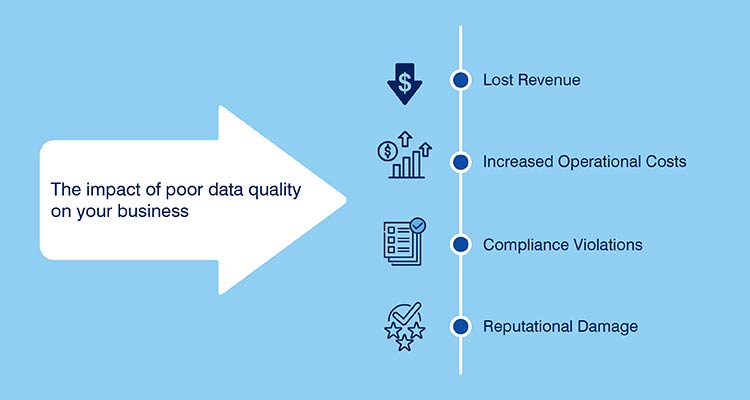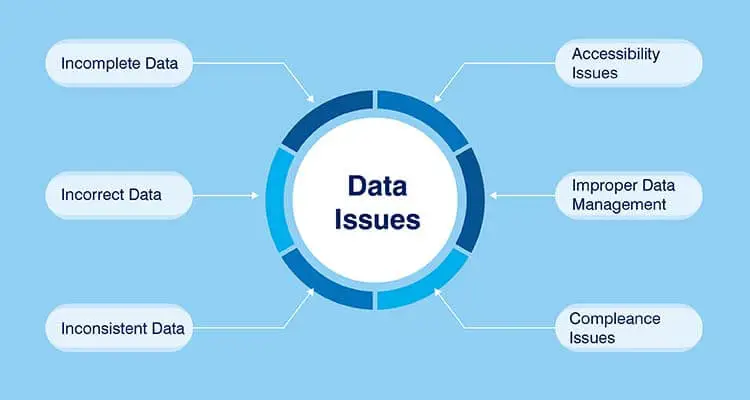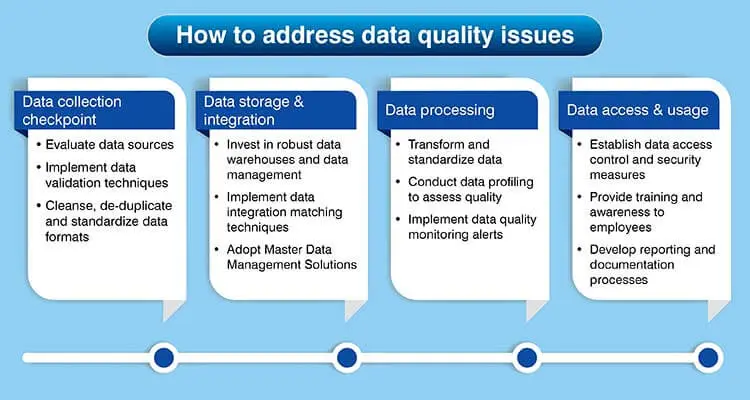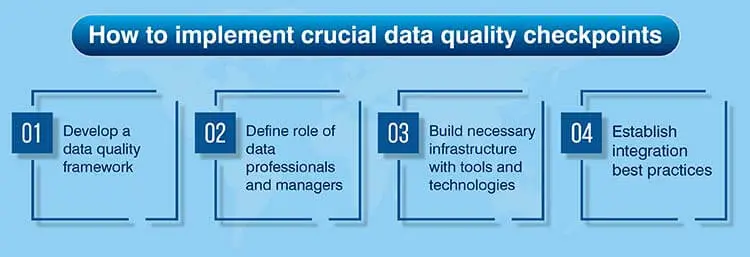Data quality serves as a vital element for the enduring success of your business, particularly in today’s increasingly data-centric landscape. Superior data quality can propel enhanced customer experiences, leading to improved retention and ultimately, boosting top-line revenue.
Contents
- Definition of data quality issues
- Understanding data quality issues
- Impact of data quality issues on organizations
- Here are the key 4 checkpoints to address data quality issues
- Implementing data quality checkpoints
- Data quality maintenance and continuous improvement
- Benefits of implementing data quality checkpoints
- Conclusion
What if you received an email that is not addressed to you, correctly? Your confidence in the sender company will be eroded forever. Wrongly spelled customer name, incomplete information, hidden data- all of these are problems associated with data quality.
Poor data quality costs about $12.9 million to organizations, as per a Gartner report. In addition to the immediate impact on bottom line, in the long term, poor data quality complicates data ecosystems and leads to ineffective decision making.
Definition of data quality issues
Data quality issues refer to any problems or discrepancies in the data that can negatively impact its accuracy, consistency, completeness, timeliness, or relevance. Common data quality issues include duplicate records, missing values, incorrect data entries, and inconsistent formatting.
Importance of addressing data quality issues
- Poor data quality can lead to incorrect decision-making, resulting in suboptimal strategies and missed opportunities.
- Inaccurate or inconsistent data can cause inefficiencies in business processes and increase operational costs.
- Data quality issues can negatively impact customer relationships, as inconsistent or incorrect data can erode trust and loyalty.

This article explores four crucial checkpoints to effectively address data quality issues, enabling businesses to harness the power of high-quality data for informed decision-making, optimized operations, and enhanced competitiveness in the data-driven landscape of 2023.
Understanding data quality issues
Data quality issues refer to any problems or discrepancies in the data that can negatively impact its accuracy, consistency, completeness, timeliness, or validity. Common types of data quality issues include:
- Accuracy: Inaccurate data entries or incorrect information in the dataset.
- Completeness: Missing values or incomplete records in the dataset.
- Consistency: Inconsistent data formats or conflicting information across different data sources.
- Timeliness: Outdated or stale data that does not reflect the current state of the business or market.
- Validity: Data that does not conform to predefined rules, standards, or expectations.
Impact of data quality issues on organizations
Data quality issues can have significant consequences for organizations, affecting various aspects of their operations:
- Decision-making: Poor data quality can lead to incorrect decision-making, resulting in suboptimal strategies, missed opportunities, and increased costs.
- Reputational risk: Data quality issues can damage an organization’s reputation, as customers, partners, and stakeholders may question the reliability of the company’s data and decision-making processes.
- Compliance and regulatory concerns: Inaccurate, incomplete, or inconsistent data can lead to non-compliance with data protection regulations and industry standards, resulting in fines, penalties, and reputational damage.
- Customer trust and satisfaction depletion: Data quality issues can negatively impact customer relationships, as inconsistent or incorrect data can erode trust and loyalty, leading to decreased customer satisfaction and potential loss of business.

Here are the key 4 checkpoints to address data quality issues
In an age where data drives decision-making across industries, ensuring its quality is more paramount than ever before. As we navigate through 2023, businesses face an evolving landscape of challenges and technological advancements.
Amidst this dynamic environment, maintaining impeccable data quality can be the game-changer. In this blog, we’ll delve into the four pivotal checkpoints that every organization must consider to address and rectify data quality issues, ensuring that their data remains an invaluable asset rather than a potential liability.

1. Data collection checkpoint
- Data source evaluation: Assess the reliability and relevance of data sources to ensure that the collected data is accurate and representative of the target population.
- Data validation techniques: Implement data validation techniques, such as range checks, consistency checks, and pattern matching, to identify and correct errors and inconsistencies during data collection.
- Data cleansing methods: Apply data cleansing methods, such as deduplication, filling in missing values, and standardizing data formats, to improve data quality and consistency.
2. Data storage and integration checkpoint
- Data warehouse and database management: Invest in robust data warehouse and database management systems to ensure efficient data storage, retrieval, and management.
- Data integration and data matching: Implement data integration and data matching techniques to consolidate data from various sources and formats, enabling comprehensive analysis and insights.
- Master data management (MDM) solutions: Adopt MDM solutions to maintain a single, consistent, and accurate view of critical business data, such as customer, product, and supplier information.
3. Data processing checkpoint
- Data transformation and standardization: Transform and standardize data to ensure consistency and compatibility across different data sources and systems.
- Data profiling and data quality metrics: Conduct data profiling to assess data quality and establish data quality metrics to measure and track data quality over time.
- Data quality monitoring and alerts: Implement data quality monitoring and alert systems to proactively identify and address emerging data quality issues.
4. Data access and usage checkpoint
- Data access control and security measures: Establish data access control and security measures to protect data from unauthorized access, breaches, and misuse.
- Data training and awareness programs: Provide data training and awareness programs to educate employees on the importance of data quality and best practices for data collection, storage, and usage.
- Data quality reporting and documentation: Develop data quality reporting and documentation processes to ensure transparency, accountability, and continuous improvement in data quality management.
By prioritizing data quality and adopting data hygiene best practices, businesses can maintain a competitive edge and drive success in the ever-evolving data-driven world.
Implementing data quality checkpoints
Development of a quality framework, defining the role of data quality professionals and managers, establishing a seamless collaboration between IT and business teams and integration with data governance practices across the organization becomes crucial to implement data quality checkpoints.

Developing a data quality framework
A data quality framework is a structured approach to managing and improving data quality within an organization. It includes:
- Defining data quality objectives and metrics
- Establishing data quality processes and best practices
- Implementing data quality tools and technologies
- Monitoring and measuring data quality performance
Developing a data quality framework helps businesses systematically address data quality issues and ensure that their data remains accurate, consistent, and reliable.
Role of data professionals and data quality managers
Data stewards and data quality managers play a critical role in implementing data quality checkpoints:
- Data professionals: Data professionals are responsible for ensuring the quality, consistency, and accuracy of data within their domain. They collaborate with IT and business units to define data quality objectives, implement data quality processes, and monitor data quality performance.
- Data quality managers: Data quality managers oversee the organization’s data quality initiatives, coordinate data quality efforts across different domains, and ensure that data quality best practices are followed throughout the organization.
Collaboration between IT and business units
- IT teams provide the necessary infrastructure, tools, and technologies to support data quality initiatives.
- Business units define data quality objectives, provide domain-specific expertise, and ensure that data quality processes align with business goals and strategies.
Integration with data governance practices
Data quality checkpoints should be integrated with broader data governance practices, such as:
- Data privacy and security policies
- Data lifecycle management
- Data cataloging and metadata management
Step up your data quality game with the right tools.
Get a FREE quote »Data quality maintenance and continuous improvement
To ensure long-term success in addressing data quality issues, businesses must focus on data quality maintenance and continuous improvement. This involves:
Periodic data quality assessments
- Conducting regular data quality assessments helps businesses identify and address emerging data quality issues before they escalate. These assessments involve:
- Evaluating the accuracy, completeness, consistency, timeliness, and validity of data.
- Identifying data quality trends and patterns.
- Prioritizing data quality issues based on their impact on business operations and decision-making.
Addressing data quality issues in real-time
- Real-time data quality monitoring and correction enable businesses to proactively address data quality issues as they arise. This can be achieved by:
- Implementing automated data validation and cleansing processes that identify and correct errors and inconsistencies in real-time.
- Integrating data quality tools and technologies with existing systems and processes to ensure seamless data quality management.
Feedback mechanisms and user inputs
- Incorporating feedback mechanisms and user inputs into data quality processes helps businesses continuously improve data quality by:
- Encouraging users to report data quality issues and provide suggestions for improvement.
- Implementing user feedback and suggestions to refine data quality processes and best practices.
Data quality audits and performance metrics
- Regular data quality audits and performance metrics help businesses track and measure their data quality performance over time. This involves:
- Establishing data quality performance metrics, such as error rates, data completeness, and data consistency.
- Conducting data quality audits to assess compliance with data quality standards and best practices.
- Using data quality performance metrics to identify areas for improvement and track progress towards data quality objectives.
Benefits of implementing data quality checkpoints
Implementing data quality checkpoints offers several benefits for businesses, including:
- Improved decision-making: High-quality data enables businesses to make better-informed decisions, leading to more effective strategies, reduced risk of costly mistakes, and improved business performance.
- Enhanced operational efficiency: Accurate and consistent data streamlines business processes, reduces the time and resources spent on data cleaning and validation tasks, and improves overall operational efficiency.
- Increased data value and usability: By maintaining high-quality data, businesses can increase the value and usability of their data assets, enabling them to derive more insights and drive better outcomes from their data-driven initiatives.
- Enhanced data governance: Implementing data quality checkpoints helps businesses establish and maintain robust data governance practices, ensuring compliance with data protection regulations and industry standards, and reducing the risk of fines, penalties, and reputational damage.
Discover the essential steps to address data quality issues. Learn how to identify, prevent, and resolve data quality problems. This concise and engaging video will guide you through the process of ensuring data accuracy, consistency, and reliability, ultimately empowering your business to make better-informed decisions and achieve success in the data-driven world.
Conclusion
Throughout this blog, we have explored the importance of addressing data quality issues and discussed four crucial checkpoints like data collection checkpoint, data storage and integration checkpoint, data processing and data access and usage checkpoint to effectively manage data quality.
As a call-to-action, we encourage organizations to prioritize data quality and implement these checkpoints to ensure that their data remains accurate, consistent, and reliable. In conclusion, the future of data quality management will continue to evolve as businesses increasingly rely on data-driven insights and decision-making.
Ready for top-notch data quality this year?
Contact our data experts today »




